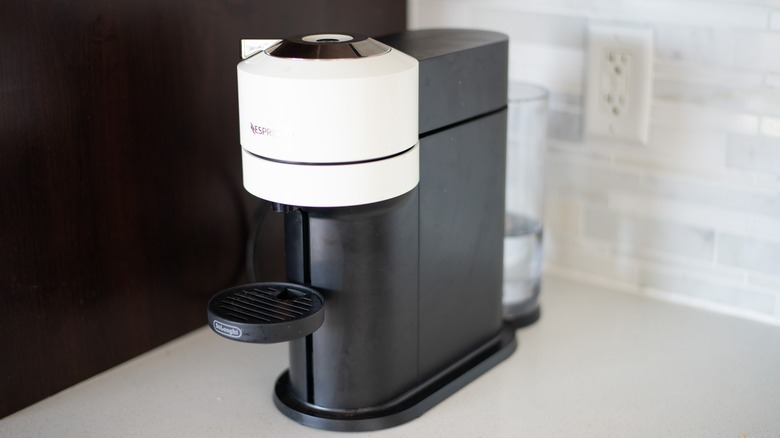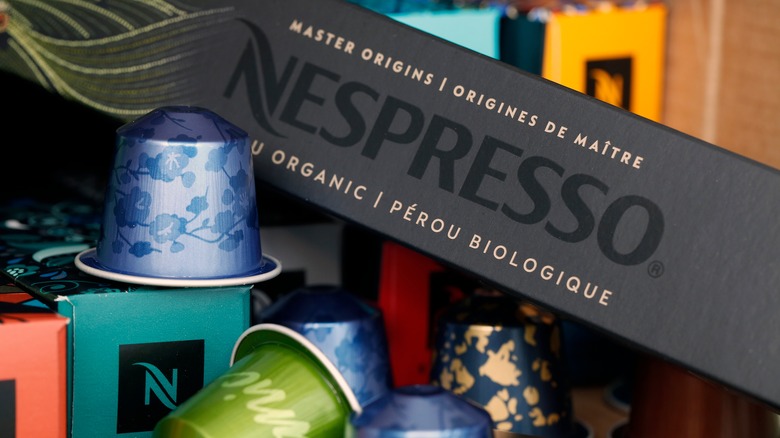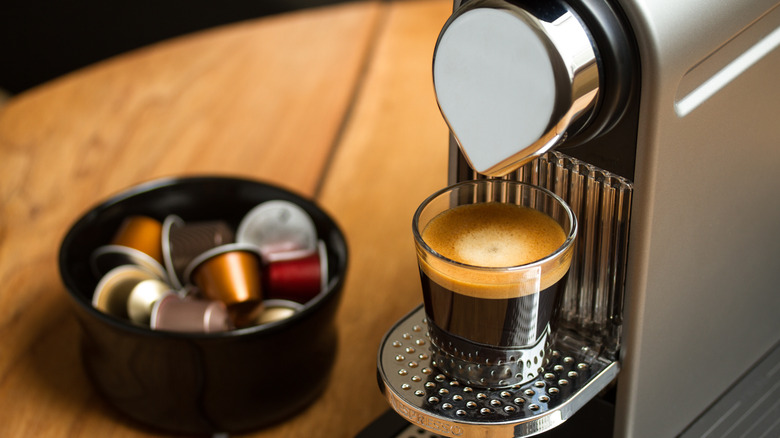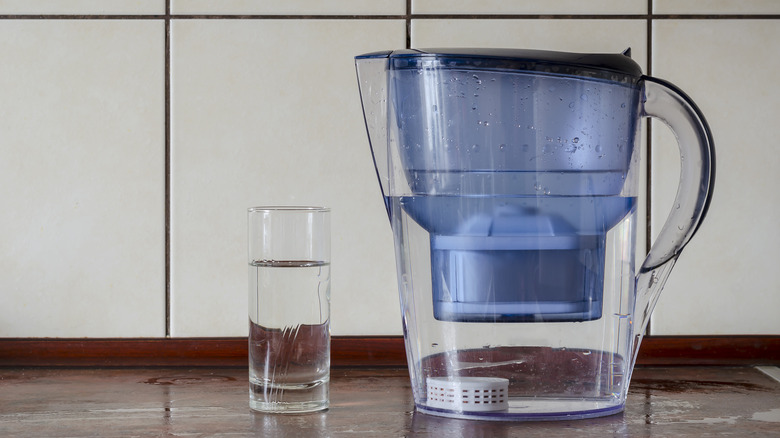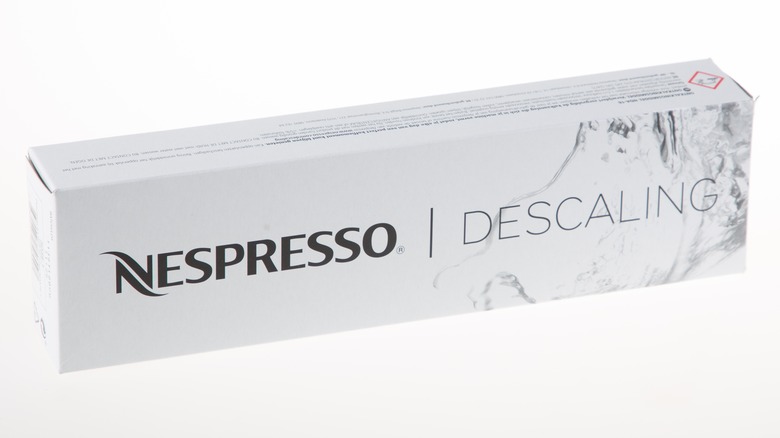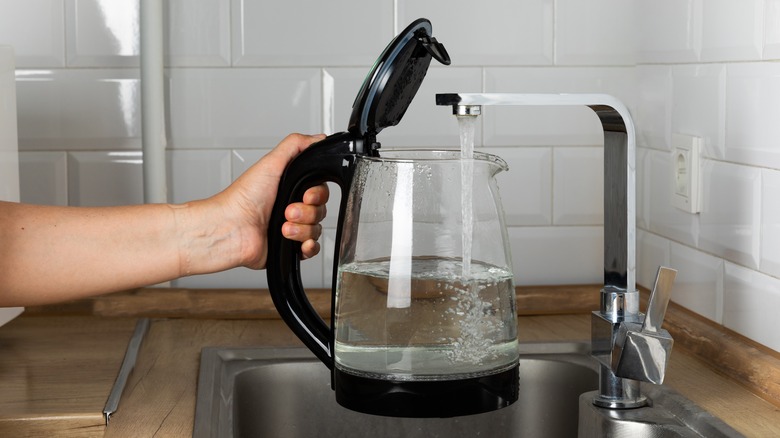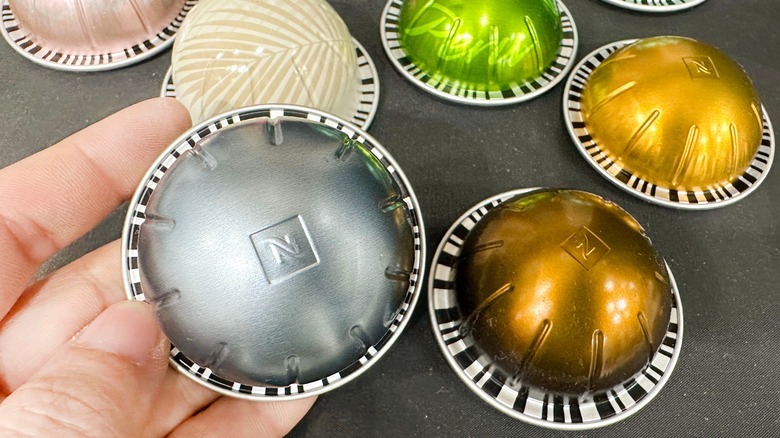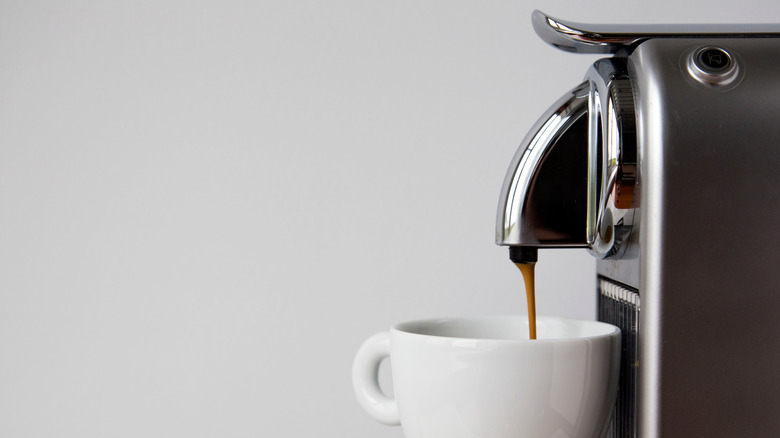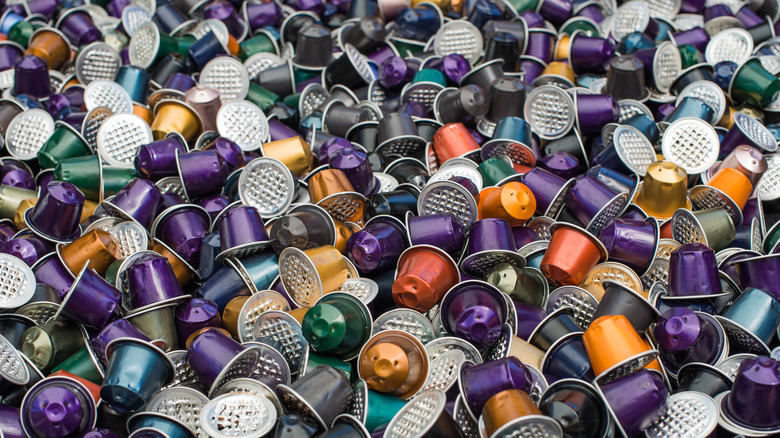10 Mistakes To Avoid When Using Your Nespresso Machine
Never figured out how to make a decent espresso? No worries — you're not alone. It can be tricky to master making the perfect brew, and not everyone has dreams of becoming a barista someday. But just because you may not be a top-notch espresso-maker yourself doesn't mean you can't enjoy a delicious espresso in the comfort of your own home. It just means that you might want to invest in a Nespresso machine, which may just be one of the easiest ways to enjoy espresso in your own kitchen without going through the tricky process of brewing your own cup.
While using a Nespresso machine may be easy — and certainly easier than using a traditional espresso maker — that doesn't mean it's completely foolproof. In fact, there are a lot of potential mistakes you can make when you're brewing a cup of espresso in your Nespresso. Learn how to avoid those common pitfalls by checking out these mistakes to avoid when using your Nespresso machine. Once you understand what could potentially go wrong, you can guarantee a delicious at-home espresso every day of the week. Now that's a delicious way to start your day.
Storing your Nespresso machine in a humid location
It's true that Nespresso machines are typically pretty easy to use, but something as simple as storing the machine in the wrong part of your home could cause issues for you — and for your morning cup of coffee. These machines don't tend to have issues very often, but you may start to notice some problems if you store your Nespresso in a place that's too humid, which can sometimes be the case in kitchens, particularly if you don't have central air conditioning in your home or you live in a basement apartment.
If your kitchen gets steamy on the regular, you may want to consider storing your Nespresso machine in a cool, dry place away from those sticky conditions. In many kitchens, storing the machine in a cabinet is a good option. You'll want to opt for a cabinet or closet that stays pretty close to room temperature, as fluctuating temperatures and humidity levels can cause your machine to function at less-than-peak performance. Don't forget to remove the water tank before you put your machine away, as any extra water can contribute to increased humidity levels. Keep your machine cool and dry as much as possible, and you'll be sipping on espressos for years to come.
Leaving old Nespresso pods in the machine
Many coffee drinkers are in a rush in the mornings. After all, isn't that part of the reason you're drinking coffee in the first place — because you want a rush of energy to help you get out the door and get on with your day? But just because you're in a hurry doesn't mean you should leave a used pod in your Nespresso machine all day. In fact, it's important that you remove the used pod as soon as your cup of espresso is brewed. That's because the pod gets wet when you brew a cup of espresso, and all that moisture is trapped in a small, dark space. And what usually happens when moisture is stuck in a cool, dry place? That's right: Mold starts to grow.
Mold can grow in the pod itself, of course, which is gross. But it's fine if you're just throwing the pod away once you're ready to brew your next cup of coffee, right? Well, maybe not. That mold growth can also accumulate on the metal spikes that pierce the pod when you start brewing an espresso in your Nespresso machine, so it's best to remove the pod immediately after you use it. This will help ensure that your Nespresso machine stays as clean — and as mold-free — as possible.
Not using fresh Nespresso pods
When you brew your own espresso from scratch, you have to take a good look at the coffee grounds before you actually brew, which can help you determine if you're actually getting fresh coffee or not. Unfortunately, when you use a Nespresso, you're using pods that completely obscure the appearance of the coffee, so you don't really have any indication of how fresh the coffee in the pod is. For the best-brewed cup of espresso, you'll want to use the freshest coffee possible.
So, how can you tell if you're actually using a fresh Nespresso pod? It's easy. Take a good look at the pod itself, and press on the aluminum foil membrane that stretches across the top of the pod. If it feels tight and firm, you're in luck — the coffee inside of the pod is still fresh. On the other hand, there's a chance that the foil membrane will feel loose and flimsy. If that's the case, then chances are that the coffee inside the pod is actually not that fresh, and you can probably trash it. By using fresh pods, you can ensure that you make the most of your Nespresso machine every time you brew a cup.
Not preheating your Nespresso machine
One factor that really matters when it comes to brewing the perfect cup of espresso? Temperature. You want the water to be at just the right temperature to bring out the rich flavors of the coffee without accidentally burning it in the process. However, you have less control over temperature with a Nespresso machine than you might with other coffee-making devices. Technically, your Nespresso should be able to set the water to the correct temperature. But if you really want to make sure your espresso will come out at the perfect temperature, you may want to consider preheating the machine.
Luckily, preheating the machine is easy. Simply run the machine through one cycle without a capsule before actually making your coffee. Then, check to make sure you have enough water left, add in the pod, and brew your espresso. Although it takes a bit of extra time, ensuring your coffee is at the perfect temperature will make you enjoy each sip that much more.
Forgetting to use filtered water
This mistake may not apply to every Nespresso owner out there because the quality of your local tap water makes a huge difference in how your cup of espresso turns out. If you like the flavor of the water that comes out of your taps, then go ahead — feel free to use it to brew your morning coffee. If, on the other hand, you're not a fan of the flavor, it's probably a better idea to filter your water before you run it through your Nespresso machine. That's because coffee is made up mostly of water. Therefore, even if you like your espresso particularly strong, you're still going to pick up on the flavor of the water you use. For the best-tasting results, only use water you wouldn't mind drinking plain.
Another reason to consider using filtered water is the fact that hard water can cause a buildup of minerals in your Nespresso machine, which could eventually affect its performance.
Neglecting to clean your Nespresso machine regularly
Just like any appliance in your kitchen, your Nespresso machine requires regular cleaning to keep it working at peak performance. However, it may not always be obvious when you need to clean your Nespresso. After all, most of the working parts are located inside the machine, so you may not notice how much it need to be cleaned. Therefore, you may want to set a regular cleaning schedule depending on how much you use your machine to keep gunk from accumulating and interfering with its working parts.
Luckily, the most basic Nespresso machines don't require much maintenance. You'll just want to clean the water tank and the drip tray with soapy water on a semi-regular basis. Nespresso machines that have more working parts may need extra cleaning. For example, if your Nespresso comes with a milk frother, you'll need to clean that component much more regularly.
Descaling is also an important part of the cleaning process for your Nespresso machine, as it removes the mineral buildup that accumulates over time. Your user guide will give you information on how to descale your specific machine, which involves filling the water tank with water and a descaling solution and running a descaling cycle a few times in a row.
Adding hot water to your Nespresso machine
Water that's heated to just the right temperature is important to ensure the best possible cup of espresso. And because you want that water heated perfectly, you may think that it's a good idea to use especially hot water (or at least warm water) when you fill the tank of your Nespresso machine. Although that may seem like a solid idea, you'll actually want to avoid using heated water when making your coffee in a Nespresso. In reality, it's better to use cold or cool water.
Your Nespresso is designed to work with cooler water, so it shouldn't have a problem heating it up in the machine once you're ready to brew your coffee. Therefore, you don't have to spend minutes at the sink waiting for the water to heat up or think about boiling a pot of water or a kettle to ensure the water for your Nespresso is at the right temperature. If you're still worried about making sure you're working with the right temperature, try preheating the machine.
Thinking you can use any pods in a Nespresso Vertuo machine
So, you have a Nespresso machine. But do you know which type you have? There are several different types of Nespresso machines on the market, so you'll want to pay close attention to the model you're using. One of the brand's popular products is the Nespresso Virtuo machine. This machine is special because it can "read" codes that are present on specific Nespresso pods. These codes tell the machine what kind of coffee you're brewing, so it gives you a perfect cup every time, adjusting the temperature and water to coffee ratio in the process.
Sounds great, right? It's definitely a cool piece of technology, but that doesn't mean it doesn't come with some downsides. The main con to using a Nespresso Virtuo machine is the fact that you can only use Virtuo pods with the machine — other Nespresso pods won't work. What's more, you can't even get pods from other companies, which requires you to stick with Nespresso products specifically. This can get pricey over time, and it can sometimes be difficult to find the right pods when you're shopping at a grocery store. So, the next time you're looking for pods, make sure you're grabbing the Virtuo variety to match your machine.
Always choosing the default brew button settings
Take a look at the top of your Nespresso machine. Most basic versions feature two buttons: one for an espresso and another for a lungo. Some varieties will have additional buttons to make other types of coffee drinks. These buttons will add a certain amount of water to your cup of coffee, giving you a different brew depending on the button you choose. But if you've used both (or all) of these settings and neither (or none) of them seem to give you the ratio of coffee to water you're looking for, there's an easy solution: Just control the water content yourself.
Most Nespresso machines have a feature that makes it easy for you to decide just how much water you want to add to your cup. Instead of just pressing the button once and immediately releasing it, press and hold the button instead. The coffee will start dispensing from the machine. When you decide you have enough water in your cup, you can release the button, and the flow will stop. This way, you have more control over how your cup of coffee ends up, whether you prefer a more or less diluted brew.
Forgetting to recycle used pods
The convenience of a Nespresso machine is hugely appealing for many coffee drinkers. However, that convenience comes at a cost: All those used pods create a lot of waste — especially if you're drinking coffee on a regular basis. This is inherently wasteful, and there are, of course, more sustainable ways of making your morning brew at home. However, if you still want to stick with your Nespresso machine, there are ways of making your espresso more sustainable.
The brand uses recyclable aluminum to make its capsules, and it owns its own recycling facilities. It may not necessarily be easy to get them there — you'll have to separate them from the rest of your trash and then take them to a Nespresso store or another collection point — but it's certainly worth the time and effort if you're invested in recycling and want to make your morning coffee routine just a bit less wasteful. Live in New York City? Then, it's even easier to recycle your used Nespresso pods. You can actually put them in the city's recycling bins. Outside of the United States, there are some locations where you can get your used pods picked up from home. Of course, recycling doesn't mitigate all the negative environmental impacts that brewing coffee this way creates, but it's a good start on your road to a more sustainable kitchen.

